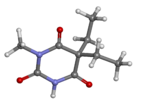 | |
 | |
| Clinical data | |
|---|---|
| Other names | Endiemal, metharbitone, methobarbitone[1] |
| Routes of administration | By mouth (tablets) |
| ATC code | |
| Legal status | |
| Legal status |
|
| Identifiers | |
| |
| CAS Number | |
| PubChem CID | |
| IUPHAR/BPS | |
| DrugBank | |
| ChemSpider | |
| UNII | |
| KEGG | |
| ChEMBL | |
| CompTox Dashboard (EPA) | |
| ECHA InfoCard | 100.000.011 |
| Chemical and physical data | |
| Formula | C9H14N2O3 |
| Molar mass | 198.222 g·mol−1 |
| 3D model (JSmol) | |
| |
| |
| (verify) | |
Metharbital was patented in 1905 by Emil Fischer working for Merck.[2] It was marketed as Gemonil by Abbott Laboratories. It is a barbiturate anticonvulsant, used in the treatment of epilepsy.[3][4] It has similar properties to phenobarbital.
History[edit]
- 1952 Gemonil was introduced by Abbott Laboratories.
- 1990 Abbott stopped marketing.
Synthesis[edit]
Metharbital can be synthesized from 2,2-diethylmalonic acid and O-methylisourea.[5][6][2]
References[edit]
- ^ "Metharbital". The Comparative Toxicogenomics Database.
- ^ a b US 782742, Fischer E, "Trisubstituted barbituric acids and process of making them.", issued 14 February 1905, assigned to E. Merck
- ^ Shorvon SR, Fish DR, Perucca E, Dodson WE, eds. (2004). The Treatment of Epilepsy (2nd ed.). Blackwell. ISBN 0-632-06046-8.
- ^ Resor SR (1991). The Medical Treatment of Epilepsy. Marcel Dekker. ISBN 0-8247-8549-5.
- ^ Halpern A, Jones JW (June 1949). "The characterization of the trialkylbarbiturates". Journal of the American Pharmaceutical Association. 38 (6): 352–5. doi:10.1002/jps.3030380619. PMID 18151714.
- ^ Snyder JA, Link KP (1953). "Preparation and Characterization by Alkaline Methanolysis of 5,5-Diethyl-4-(tetraacetyl-β-D-glucosyloxy)-2,6(1,5)-pyrimidinedione". Journal of the American Chemical Society. 75 (8): 1881–1883. doi:10.1021/ja01104a030.
Well, that’s interesting to know that Psilotum nudum are known as whisk ferns. Psilotum nudum is the commoner species of the two. While the P. flaccidum is a rare species and is found in the tropical islands. Both the species are usually epiphytic in habit and grow upon tree ferns. These species may also be terrestrial and grow in humus or in the crevices of the rocks.
View the detailed Guide of Psilotum nudum: Detailed Study Of Psilotum Nudum (Whisk Fern), Classification, Anatomy, Reproduction